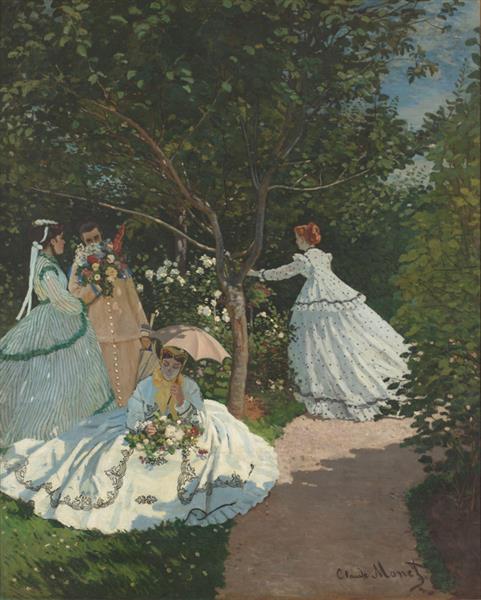Description
The work "Women in the Garden", painted by Claude Monet in 1866, is a splendid reflection of the artist's innovative approach to light and colour, defining characteristics of the Impressionist movement of which he was one of the main exponents. This painting is particularly notable not only for its technique, but also for the social context it evokes, depicting the daily life of women in 19th-century France, surrounded by the lush nature of a garden.
In the composition, Monet achieves a dynamic and balanced arrangement of figures moving in an intense natural environment. The women, dressed in contemporary costumes that reveal the fashions of the time, are arranged on different planes of depth, giving a sense of three-dimensionality. The colors he uses are vibrant and energetic; greens and yellows predominate, as well as a variety of tones that accentuate the luminosity. Monet's characteristic loose brush technique allows the light to diffuse across the palette, suggesting the warmth of the day outside. The interplay between light and shadow is masterful, and the sun plays between the trees, creating an extremely natural and welcoming atmosphere.
The work is also a beautiful example of the use of colour to convey emotion and atmosphere. Monet chooses deep and soft shades of green, combining different hues to represent the lush vegetation of the garden. The shadows on the women's dresses tell a visual story in which their postures and gestures intertwine with the life of the surroundings. Each figure, although part of the same narrative, seems to have its own story; the viewer is drawn to explore the subtle interactions that occur between them, even in a space that lacks a strictly defined narrative control.
It is relevant to mention that "Women in the Garden" has a personal background. Monet portrayed several women in his intimate circle, including his lover at the time, Camille Doncieux. The choice to depict women in this natural setting could reflect his admiration and respect for them, and his personal closeness to these characters. This gives the work an emotional charge that distinguishes it, providing a dimension beyond mere aesthetic representation.
Furthermore, this painting can be read as a symbol of social change. The women in the garden, removed from the restrictions of domestic space, are a reflection of the growing visibility of women in 19th-century European society, a time when their public role and place in the social sphere was beginning to be questioned. Monet, through his art, captures a moment of freedom and autonomy, a theme that would resonate in his later work and the Impressionist movement in general, which advocated a freer and more authentic approach to representation.
In short, “Women in the Garden” is not only a stunning work of art, but also a significant record of the social and emotional life of the 19th century. Through its innovative composition, masterful use of color, and subjective representation of its characters, Claude Monet invites us into a world where light, nature, and human relationships intertwine in a sublime way. This work represents not only a turning point in the painter’s career, but also an important moment in the history of art, where conventions are challenged and new ways of seeing and feeling are explored.
KUADROS ©, a famous painting on your wall.
Hand-made oil painting reproductions, with the quality of professional artists and the distinctive seal of KUADROS ©.
Painting reproduction service with satisfaction guarantee. If you are not completely satisfied with the replica of your painting, we will refund 100% of your money.

